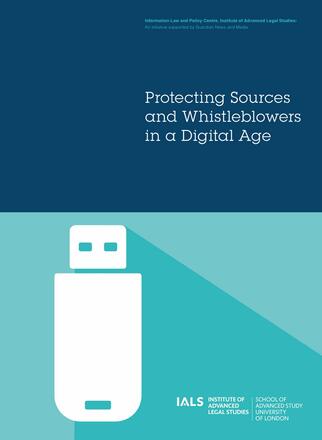
Protecting Sources and Whistleblowers in a Digital Age
Protecting sources, whilst viable for investigative journalism, has become increasingly difficult for journalists due to a number of policies and legislative proposals that have substantially weakened protections for sources. This report takes the move from the current challenges faced in the UK to open up the topic and formulate recommendations that fit well in the ongoing debate on the protection of whistleblowers in the EU.
“Protecting Sources and Whistleblowers in a Digital Age” draws from the findings of a research initiative on confidential source and whistleblower protection by the Information Law and Policy Centre at the Institute of Advanced Legal studies. The report also uses opinions and background information from a specialist group. The focus-group consisted of 25 people, among which were investigative journalists, representatives from relevant NGOs and media organisations, media lawyers, and scholars. Their related meeting took place in September 2016.
The report goes into detail explaining specifics of British law as it relates to the topic being discussed, elaborating further on their emergence, loopholes and practical use by authorities today. Whilst the participants – undisclosed under the Chatham House Rules – seem to be concentrating on the situation in the UK, their recommendations hold value for an international audience.
The report is divided into four main chapters, covering respectively the legal framework, practical considerations, technological factors and recommendations. It gives most attention to the debate around the legal framework concerning the matters of whistleblowers and investigative journalists. Readers learn about the shortcomings of laws such as the Police and Criminal Evidence Act of 1984 (PACE).
The discussants subsequently argue that a judicial definition of journalists is needed. Questions of who owns what information during the process of working as an investigative journalist are highlighted.
Turning to more practical considerations, the study tackles issues such as housing for whistleblowers, psychological aspects of keeping contact with a source and threat assessments by journalists. As far as technological aspects are concerned, the article discusses the safety of “drop boxes” and cryptography techniques. One example is “Pretty Good Privacy” (PGP), said to be difficult to use and therefore not always practical.
An important point is that technology and capabilities to gain access to information from and about journalists become more decentralized and potentially available to wide groups of individuals. The act of meeting in person or using “traditional” means of communication (fax or letter) is often less vulnerable to hacking, but does not guarantee total safety neither for the journalist nor for the whistleblower.
The authors make separate recommendations at the end of their report, addressing both policy makers and journalists. They advise policy makers to check whether the law provides sufficient protection for journalists and whistleblowers: that the disclosure of information, if in the public interest, is not illegal and that judicial oversight is guaranteed for all cases against journalists and their sources.
Turning to journalists and their organisations, the panel agrees that more training is needed on source protection and on how to engage with whistleblowers. Additionally, news organisations should strengthen their security measures, whilst national unions for journalists may provide similar services to freelance media workers.
Tags: Whistleblowing Access to information Cybersecurity Investigative journalism United Kingdom EU Member StatesThe content of this article can be used according to the terms of Creative Commons: Attribution-NonCommercial 4.0 International (CC BY-NC 4.0) . To do so use the the wording "this article was originally published on the Resource Centre on Media Freedom in Europe" including a direct active link to the original article page.

